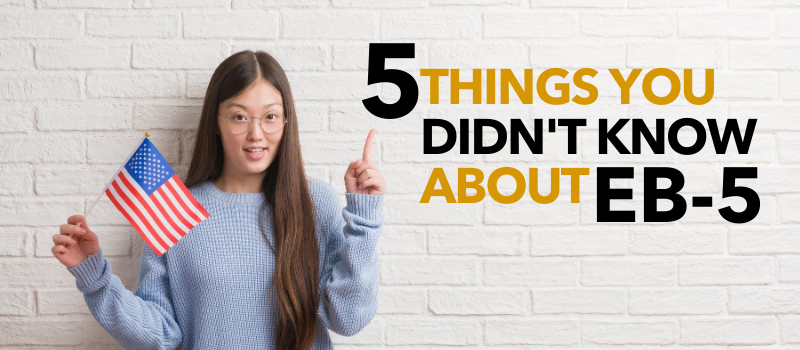Little-Known EB-5 Facts: Five Things You Didn’t Know About EB-5

Since 2012, the number of issued EB-5 visas has been growing at a fast pace. Although the program grows in popularity, there still remain a few little-known EB-5 facts. Here is our list of the five things most investors didn’t know about EB-5.
1. EB-5 is Different Than Other Employment-Based Visas
The employment-based immigration category includes EB-1, EB-2, EB-3, EB-4 and EB-5 visas. The first four types require that an employer files a petition on behalf of the immigrant, whether they have extraordinary abilities, are professionals holding an advanced degree, skilled workers or religious workers, physicians or armed forces members, etc. In contrast, the EB-5 visa does not require employer sponsorship. Rather the EB-5 applicant is expected to create 10 full-time jobs for American workers. This is also a main differentiator when comparing the EB-5 to the popular H-1B visa which also requires employer sponsorship and a lottery selection process.
2. The EB-5 Annual Cap Is Not a Fixed Number
The EB-5 program has an annual maximum of approximately 10,000 new visas issued per year. However, the numerical limit is not a fixed number. 7.1% of a total number of EB visas that varies each year, further divided by the 7% per country cap. For fiscal year 2019 the share of EB-5 visas was 10,076 which put the individual country share at 705 visas. According to the annual numerical limits published by the U.S. Department of State published in November, 2019, additional 1,111 visa numbers will be allocated to EB-5 in FY2020. This means than in FY2020, the per-country cap would be 778, which is 10% higher than the regular limit.
What is more interesting though, is the conclusion made after the chief of Visa Control and Reporting Division, Charlie Oppenheim spoke at an industry panel on June 16, 2020. Predictions state that due to the pandemic and consular closures, the EB-5 cap may not be reached in 2020 which would mean visas would roll over to the next year. Additionally, unused family-based visas would roll over to the employment-based categories and EB-5 may gain 4,200 extra visas in 2021.
3. Significant Percentage of EB-5 Investors Are Already in the U.S.
Visa statistics for consular processing vs. adjustment of status show that almost half of South Americans who received EB-5 visas in FY19 were not living in South America, but already residing in the U.S. on different visas. Likewise, 31% of the EB-5 visas issued to Europeans, and 34% of those issued to Indians, went through status adjustment in the U.S.
Hence, we observe more often than ever foreign entrepreneurs, professionals with advanced degrees, H-1B holders and other skilled workers who are already in the States seek the EB-5 path to permanent U.S. residency.
4. Majority of EB-5 Visas Are Issued Through Regional Centers
There are two ways to participate in the EB-5 Immigrant Investor program, by direct investment or through a Regional Center investment. Investing via a Regional Center has a certain number of advantages and the majority of investors undertake that path. According to FY2019 EB-5 statistics, 96% of the total EB-5 visas issued that year were through Regional Centers.
5. Promises or Guarantees of Visas or Permanent Residency Are Signs of Frauds
Investing through the EB-5 program makes an investor and his immediate family eligible to apply for a conditional visa, but there is no guarantee that USCIS will grant the conditional visas or subsequently remove the conditions on their lawful permanent residency. If any lawyer or Regional Center partner makes such promises, that is an indication of potential fraud.
USCIS carefully reviews each case and denies cases where eligibility rules are not met. Guarantees of the receipt of a visa or return on investment by an EB-5 firm would forfeit an investor’s application as not meeting requirements. For more information on how to recognize scams, the United States Securities and Exchange Commission (SEC) has outlined the warning signs of EB-5 investment fraud.
The EB-5 is a unique immigration program whose nuances present little-known facts. The more information an aspiring investor gathers, the better equipped he will be in making an educated decision when choosing the right EB-5 path, project or partner.
Obtain more information on attractive investment projects with potential for a permanent U.S. green card.











